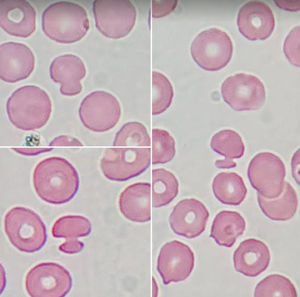Red cells with cytoplasmic projections, resembling pincer-like cells, also known as mushroom- shaped red blood cells, as Figures 1 and 2, are usually associated with erythrocyte disorders, such as congenital dyserthropoietic anemias, hereditary spherocytosis associated with Banda-3 protein deficiency, disseminated intravascular coagulation, hemolytic-uremic syndrome, thrombotic thrombocytopenic purpura, kidney disease, microangiopathic hemolytic anemia, erythroleukemia and, more rarely, oxidative drug-induced hemolysis. However, a recent study have demonstrated a relationship between these cells and infection caused by Sars-CoV-2 in a pathophysiologic mechanism that possibly involves the occurrence of oxidative stress, which triggers progressive cascade of inflammation, known as citokines storm, that leads to red blood cell damage.1–3
The Impact Factor measures the average number of citations received in a particular year by papers published in the journal during the two preceding years.
© Clarivate Analytics, Journal Citation Reports 2025
SRJ is a prestige metric based on the idea that not all citations are the same. SJR uses a similar algorithm as the Google page rank; it provides a quantitative and qualitative measure of the journal's impact.
See moreSNIP measures contextual citation impact by wighting citations based on the total number of citations in a subject field.
See more










